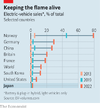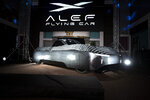JohnDe
La dolce vita
- Joined
- 11 March 2020
- Posts
- 4,903
- Reactions
- 7,298
Early last year, workers at a Jeep factory hoped their plant would be converted to an electric vehicle facility as the auto industry revamps for a green-energy future. Engineers came to take measurements for a possible retooling, and rumors spread that electric sports cars were on the agenda.
But those hopes crumbled last month when the corporate parent company, Stellantis, ended production at the 58-year-old plant and laid off roughly 1,200 workers, ripping the heart out of this small town 70 miles northwest of Chicago.
As it embarks on its biggest retooling in a century, the auto industry has announced more than $70 billion of EV investments in the United States alone. That spending is already creating new pockets of prosperity in many parts of the country — and apprehension in the long-standing auto-manufacturing communities whose fates aren’t yet certain.
Electric cars are creating a new economy — and leaving some towns behind
BELVIDERE, Ill. — Early last year, workers at a Jeep factory here hoped their plant would be converted to an electric vehicle facility as the auto industry revamps for a green-energy future. Engineers came to take measurements for a possible retooling, and rumors spread that electric sports cars were on the agenda.
But those hopes crumbled last month when the corporate parent company, Stellantis, ended production at the 58-year-old plant and laid off roughly 1,200 workers, ripping the heart out of this small town 70 miles northwest of Chicago.
The decision, now causing knock-on layoffs and lost business at local auto-parts suppliers, restaurants and shops, shows the dark side of the zero-emissions economy the Biden administration is championing with tens of billions of dollars of taxpayer-funded subsidies. Even as many communities will be transformed by the federally backed push to produce electric cars, batteries and solar panels, some will get left behind.
“Whenever you turn the ship ... you’re going to have casualties. Unfortunately the casualties are going to be our employees and our community,” Belvidere Mayor Clinton Morris said in an interview.
Federal subsidies for electric vehicles aren’t the only reason automakers are going green. But since federal officials have “put their finger on the scale” in favor of EVs, they should be doing more to lessen collateral damage for towns like Belvidere, Morris added. “If they’re going to weigh in on that, they should weigh in on how they’re going to help employees here and keep them in the community.”
As it embarks on its biggest retooling in a century, the auto industry has announced more than $70 billion of EV investments in the United States alone. That spending is already creating new pockets of prosperity in many parts of the country — and apprehension in the long-standing auto-manufacturing communities whose fates aren’t yet certain.
Protecting jobs in the EV transition will be a top concern for the United Auto Workers union as it enters negotiations with Ford, General Motors and Stellantis this year for new multiyear labor contracts. Particularly vulnerable are the jobs and Midwestern communities that manufacture the gas-powered engines and transmissions not needed in an EV.
White-collar workers also face uncertainty. General Motors in recent weeks began offering buyouts to its U.S. salaried employees as it trims costs to pay for the EV transition.
In a recent meeting with Stellantis chief executive Carlos Tavares, Biden’s climate adviser, Ali Zaidi, encouraged the auto company to apply for federal funds to help repurpose the Belvidere factory, according to a White House official, who spoke on the condition of anonymity to discuss a private meeting. Stellantis spokeswoman Jodi Tinson declined to comment.
“The president foresaw that this inevitable transition is going to pose challenges for some firms, workers and communities and that is why his agenda has specific programs to help communities,” Celeste Drake, deputy director of the National Economic Council, said by email. The programs include $2 billion in the Inflation Reduction Act for retooling auto factories and Department of Energy loans for clean-energy projects, she said.
Earlier this month, signs of the unease to come were on display in the UAW parking lot in Belvidere, where laid-off workers filed in and out of meetings to decipher their fate. Some with enough seniority can retire early with their pension benefits. Others can request a transfer to another plant out of state. Most complained that Stellantis was providing minimal information about their options.
“They ain’t telling us nothing,” Alex Lerma, a 26-year veteran with the company, said as he hurried into the building to fill out forms. “I’m going to have to move to Ohio or Michigan — it’s not clear.”
“We got passed over,” another worker muttered as he rushed by.
Aaron and Sonja Penrod, a married couple, face the possibility of being split up as Sonja pursues early retirement and Aaron considers seeking a transfer to Detroit. Sonja has enough years under her belt to get her pension, but Aaron needs three more before he’s eligible.
Sonja moved to Indiana and then Illinois to keep her job after Stellantis’s predecessor company, Chrysler, closed a factory in St. Louis more than a decade ago, and she says she doesn’t want to move to a new place again. So if Aaron heads to Detroit, she will probably retire to the farmhouse they own south of St. Louis.
“I will go visit [Aaron]. I will be in a different state, possibly 10 hours away,” she said over chips and salsa at a local restaurant.
“I’ll just go live in a little studio apartment somewhere till I get my time,” Aaron said. It’s not certain he will get a transfer, though — some of his friends who were laid off during an earlier downsizing at the factory two years ago still haven’t been offered a job at another Stellantis plant, he said.
For now, they are part of a skeleton crew still working at the Belvidere factory, disassembling and boxing up equipment, a temporary gig that they expect will end soon. Stellantis has said it is “working to identify other opportunities to repurpose the Belvidere facility,” but the Penrods see the dismantling of the machinery as a bad sign.
Also on the skeleton crew is Elise Smelser, a pipe fitter who grew up near the factory and began working there in 1999, training under the supervision of her father. Her parents, siblings and 17 nieces and nephews still live in the area and she doesn’t want to leave, but at 50 she’s too young to retire.
“I started grinding my teeth after they told us — like, during the day, not just at night when I sleep,” said Smelser, who is dreading a transfer out of state. “All my family’s here, and I have a house ... plus I would go to a place where I’d be lucky to know, like, two or three people.”
Sipping a drink at the Wild Cherries bar a day after attaching his last Jeep bumper, laid-off worker Jerome Davis said he was putting in for a transfer to Detroit, where he has family and even a house that his mother left him. He worries he’ll get sent to Toledo instead, and overall he has “no desire to leave” Belvidere, he said.
Thanks to their union, the autoworkers have strong protections during layoffs, including months of severance pay and options for those with enough seniority to retire early with a pension. But the rest of Belvidere has far less of a safety net.
Wrapping up a slow lunch hour at their Mexican restaurant in Belvidere’s quaint downtown, siblings Victor Hernandez Jr. and Iveeth Dominguez worried about losing their weekly lunch order from the factory. Every Friday they would deliver $500 or $600 worth of burritos to the plant: a good chunk of their revenue. Autoworkers have also been regular visitors to the restaurant, El Molcajete, since their father opened it in 1994.
Victor said their cousin worked at the auto factory until the last round of downsizing, when he got transferred to Detroit. He left his family behind at their house in Belvidere so his kids could stay in school, and he rents an apartment in Detroit.
“I think that’s what a lot of people are doing. They still have their family here because this is where they grew up, this is where they are based. And then they’re renting and they come back and forth,” he said. The factory closing didn’t just eliminate jobs, Victor added. “They’re also taking the people away.”
Around the corner at Buchanan Street Pub, bartender Toni Stumpf said she recently got a second job in a town half an hour away because business has slowed to a crawl in Belvidere. Lately she’s been earning $60 to $80 in tips from an 11 a.m.-to-7 p.m. shift compared with $1oo to $200 in better times.
Her usual customers “don’t have that spending money,” she said. “They’ve got enough money from unemployment to pay their bills, hopefully, you know, but they don’t have fun money.”
Across the street from a giant mural of Belvidere’s most famous daughter, the Chicago architect and MacArthur Fellow Jeanne Gang, a local barbershop stood empty on a recent afternoon. Owner James Emanuel said the town has other employers to fall back on, including General Mills, which manufactures granola bars and other foods in Belvidere and recently opened a giant distribution center.
Still, the Stellantis shutdown is “definitely going to have an effect on the community, and not just Belvidere,” he said. “It’s going to be Rockford. It’s going to be southern Wisconsin.”
After days of back-to-back meetings with union members, Kevin Logan, president of UAW Local 1268, spoke with The Washington Post about the shutdown and the “mixed emotions” he has about the electric transition.
“We’ve got to do something to reduce the emissions and everything for the environment,” he said from the empty union hall as night fell outside. But the job losses worry him, along with the lack of charging infrastructure. “I wish that we would, as a company or as a country, slowly go into it. ... I just think it’s happening so quickly.”
Logan, who worked at the factory for more than 10 years before switching to union work, said he plans to pursue early retirement to keep his family rooted in the Belvidere area. But for the past several days he’d heard story after story of workers who faced tougher decisions — spouses who didn’t know whether they could get transferred to the same city, parents worried about leaving high school kids behind in Belvidere, and workers who are caring for an elderly parent.
He also worries about the town’s tax base and ability to maintain services.
“Is the school going to start laying off teachers? You know, enrollment is probably going to go down in schools if people are moving away,” he said. “Could that be a trickledown where police start laying people off? And then does crime pick back up? It’s just a ripple effect throughout the whole community and it’s going to devastate this area.”







